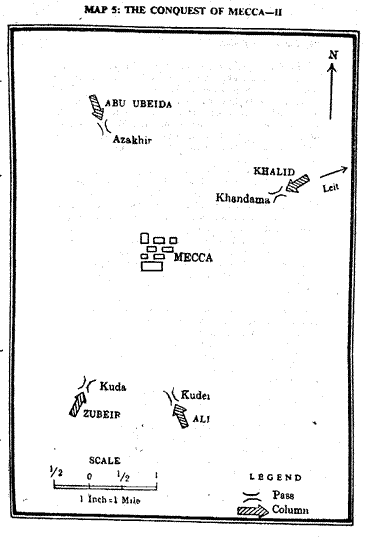|
"On this point",
replied Abu Sufyan, "there is some little doubt in my mind."
Abbas now turned fiercely on Abu Sufyan.
"Woe to you, O Abu Sufyan!" he hissed. "Submit,
or your head will be cut off!"
"I bear witness", said
Abu Sufyan hastily, "that Muhammad is the Messenger of Allah!"
Abbas now had a word with the Prophet out
of Abu Sufyan's hearing. "O Messenger of Allah",
he whispered, "Abu Sufyan is a proud man. He has dignity
and self-respect. Will you not be gracious to him and give him some
special token of esteem?" 1
At this the Prophet declared, "Whoever
enters the house of Abu Sufyan shall be safe." The
face of Abu Sufyan lit up. He had been especially honoured by Muhammad.
The Prophet continued: "Whoever locks his door shall
be safe. Whoever remains in the mosque shall be safe."
Abu Sufyan now returned to Makkah where
the people had gathered, awaiting news of their fate. Abu Sufyan
addressed the crowd: "O Quraish! Muhammad has come with
power that you cannot match. Submit to him and be safe. Whoever
enters my house shall be safe." This led to an uproar in
the crowd. "And how many do you think could fit into your
house?" the people asked with sarcasm. Abu Sufyan then
added, "Whoever stays in his house and locks his door shall
be safe. Whoever remains in the mosque shall be safe."
This appeased the crowd but could not appease
his wife, Hind. She sprang at him like a wild cat, slapped his face
and caught him by his moustaches. "Kill the fat old fool!"
she screamed at the crowd. "He has turned away from us."
Since Hind was no light-weight, the experience must have been a
painful one for Abu Sufyan. However, he managed to shake her off
and walked away to his house.'
The Muslims expected that there would be
some opposition to their entry into Makkah. They could not assume
that it would be an entirely peaceful operation although the Prophet
hoped that blood would not be shed. With hardened anti-Muslims like
Ikrimah and Safwan you could never tell. The plan of the Prophet
was therefore designed to conquer Makkah as a military operation.
Makkah lies in the Valley of Ibrahim and
is surrounded and dominated by black, rugged hills which rise in
places to over 1,000 feet above the valley floor. The town was then
approached over four routes, each one going through a pass in the
hills. These routes came in from the north-west (almost north),
the south-west, the south and the north-east. The Prophet divided
his army into four columns, one to advance on each route. The main
column, which was commanded by Abu Ubaidah and with which the Prophet
travelled in person, would enter Makkah along the main Madinah route,
from the north-west, via Azakhir. The second column, under Zubair,
would enter from the south-west, through a pass west of the Hill
of Kuda. The third column, under Ali, would enter from the south,
via Kudai; and the fourth, under Khalid, would enter from the north-east,
via Lait and Khandama. (See Map 5 below) 2

The advance consisted of convergent thrusts
aimed at a single central objective which would have the effect
of chopping up the enemy into small portions and also force dispersion
on him, so that he would be unable to concentrate for battle on
any one axis of advance. Moreover, even if the enemy succeeded in
holding up the advance on some axes, the attackers would have other
axes on which to break through and thus enjoy better prospects of
success. All approaches were used to meet this requirement of military
tactics. This was also done to prevent the escape of the Quraish;
but later, when vigilance had been relaxed, some individuals did
succeed in getting away.
1. 1bn Hisham: Vol. 2, pp. 402-5, Ibn Sad:
p. 644; Waqidi: Maghazi: pp. 327-31.
2. MISSING REFERENCE What does it refer to?-
The whole area covered by Map 5 is hilly, but since the hills could
not be accurately drawn without the aid of large scale topographical
maps, no hills are shown on the map-just the places and the directions
of the advancing columns.
| 